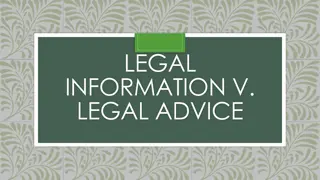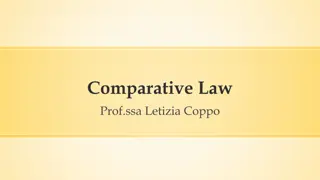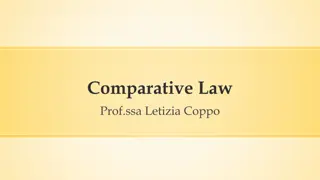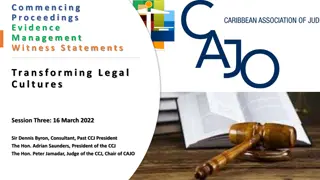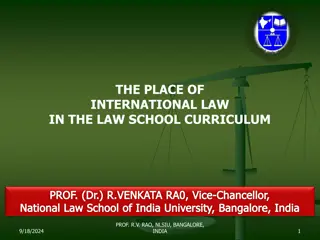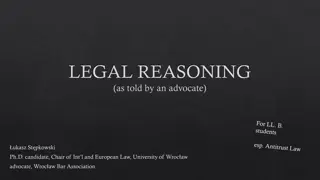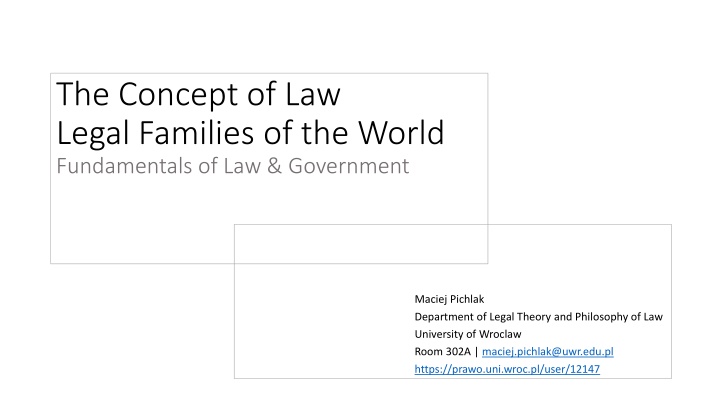
Legal Systems: Fundamentals and Functions
Explore the purpose, social functions, and multi-layered aspects of law, along with concepts like Lex et ius and sources of legal order. Delve into legal culture and its components as key aspects of the legal system.
Download Presentation

Please find below an Image/Link to download the presentation.
The content on the website is provided AS IS for your information and personal use only. It may not be sold, licensed, or shared on other websites without obtaining consent from the author. If you encounter any issues during the download, it is possible that the publisher has removed the file from their server.
You are allowed to download the files provided on this website for personal or commercial use, subject to the condition that they are used lawfully. All files are the property of their respective owners.
The content on the website is provided AS IS for your information and personal use only. It may not be sold, licensed, or shared on other websites without obtaining consent from the author.
E N D
Presentation Transcript
The Concept of Law Legal Families of the World Fundamentals of Law & Government Maciej Pichlak Department of Legal Theory and Philosophy of Law University of Wroclaw Room 302A | maciej.pichlak@uwr.edu.pl https://prawo.uni.wroc.pl/user/12147
The purpose of law To guide a human conduct To provide publicly ascertainable standards of behaviour To secure order and peace To justify acts of coercion To legitimize a domination of the ruling class over other classes Justice, security, purposiveness
Social functions of law preventing undesirable behaviour and securing desirable behaviour (criminal law, tort law) providing facilities for private arrangements between individuals (civil law) provisions of services and the redistribution of goods (administrative law, tax law) settling unregulated disputes (courts and tribunals) ------------------------------------------------------------------ Stabilization and innovation Organization Protection Repression and prevention (education)
Law as a multi-layered system Shrek Principle 'Typical' rules, that is legal provisions which are formulated in legal texts (or other traditional sources of law), creates only a 'surface-level' of law. Next to this level, law includes also other components. Concepts of legal system and legal order
Lex et ius Lex: formally enacted law Ius: a) Law in general b) lawyers-made law c) natural law d) final legal decision Ius est ars boni et aequi. Celsus
Sources of legal order Legislation (law as lex) LAW (as ius) Legal Legal practice doctrine
Legal culture A set of beliefs, attitudes and customs related to the valid law. Legal culture sensu largo and sensu stricto (culture of legal professionals). Legal culture sensu stricto is created by legal practices, legal science, and legislation
Components of legal culture (Tuori) methodical element (methods of legal reasoning) conceptual element (basic concepts of law) normative element (general legal principles) general doctrines
Law as a multi-layered system The role of legal culture (ius): Positive (binding legal standards) Negative (the limits of law) Mediating (canons of interpretations) Critical (a yardstick for criticism of law) Discursive and practical knowledge Components of legal culture and their discursive expressions.
Main legal families Civil law (Romano-Germanic) Common law (Anglo-American) Far East Islamic Hindu Scandinavian [Post-soviet]
The concept of legal family Criteria for distinguishing legal family (Koetz and Zweigert): Historical background; Methods of reasoning; Institutions; Sources of law; Dominant ideology. Other possibilities: language; territory; political system
Civil law vs. common law Source: www.frenchentree.com
Civil law Originates from the continental Europe Based on the reception of the Roman law Legislation is the primary source of law Codifications (Code of Napoleon, BGB) Similar methods of legal reasoning and interpretation Abstract, systematic; the role of legal doctrine
1900 1811 1804
Civil law: Germanic vs. Romanistic Tradition 756779 http://commons.wikimedia.org/w/index.php?curid=26 Source: By Ain92 - Own work, CC BY-SA 3.0, Germanic Romanistic Nordic Mixed Common law
Common law Originates from England, adopted in its (former) colonies Embraces legislation, regulations and judge-made law (precedents: common law in a strict sense) Precedents might be based on common law or equity Developed independently, with unique reception of the Roman law Less codified and systematized More casuistic and practically-oriented
Common law and civil law: further differences The role of judges The Rule of Law vs. Rechtsstaat Separation of powers vs. check and balance Models of judicial constitutional control


